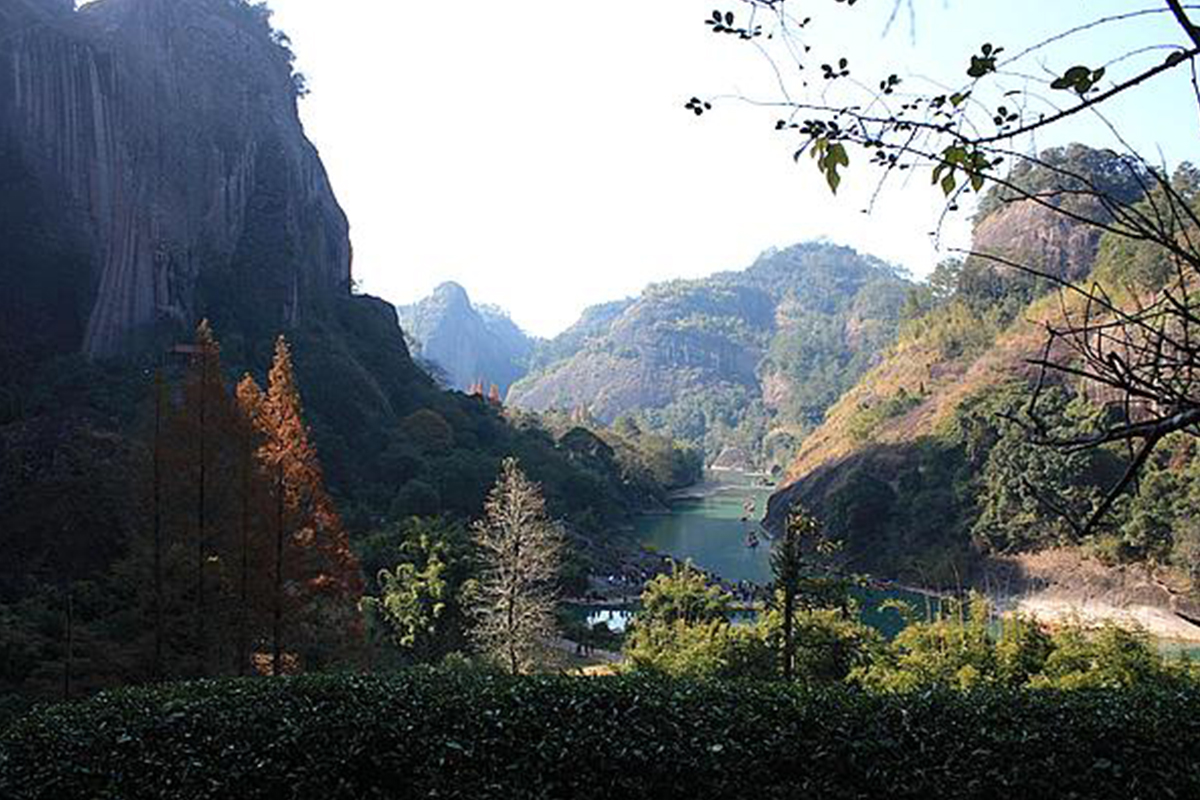 简体中文
TEL:+0086-599-5134010
简体中文
TEL:+0086-599-5134010
 简体中文
TEL:+0086-599-5134010
简体中文
TEL:+0086-599-5134010

Wuyi Mountain is of unique and precious value of natural heritage, meeting criteria (iii) and (iv) for the world natural heritage.
Wuyi Mountain is an outstanding example of biological evolution process and the relationship between man and nature.
Wuyi Mountain features the largest, best-preserved and most typical central subtropical original forest eco-system so far existing on the same latitude in the world, and has an obvious vertical plant spectrum. With the increase of the elevation, there are successively five zones: the evergreen broad-leaf forest (350-1,400m, hilly red earth), coniferous and broad-leaf forest (500-1,700m, hilly yellow and red earth), coniferous forest (1,100-1,970m, hilly yellow earth), mid-mountain meadow (1,700-2,158m, hilly yellow and red earth), mid-mountain mossy dwarf forest (1,700-1,970m, hilly yellow earth), and mid-mountain meadow (1,700-2,158m, hilly meadow soil). Some rare floras grow here, such as Tsuga chinensis (Franch.) Pritz, Common Boxwood, and Yushania wuyishanensis. Almost all subtropical original evergreen broadleaf forest and rock vegetation of China can be found in the mountain.
Wuyi Mountain is a key area for global biodiversity protection, and harbors some rare and endangered species. Located in a central subtropical monsoon climate zone, Wuyi Mountain region features rolling hills at different heights, with the absolute height difference up to 1,700m. The sound eco-environment and special geographic location make it a “natural shelter” for many plants and animals during the geographic evolution and rich in various resources.
(1) Rich varieties of plants: There are 3,728 varieties of plants that have been known in Wuyi Mountain so far. The spermatophyte ranks among the top places in the central subtropical region in terms of the number, including 31 species of 27 genera unique to China. Many of them such as the ginkgo are unispecific, and the relict plant varieties total 3,728. A total of 28 rare and endangered species such as Chinese tulip tree, halesia macgregorii, Tsuga chinensis (Franch.) Pritz, Tsoongiodendron odorum and Ageratina adenophora have been included into the China Plant Red Data Book. The species of orchidaceae plants are particularly rich in Wuyi Mountain, and 78 species of 32 genera have been known so far. Among them, Yoania japonica and Y. amagiensis are newly recorded species of China, and Lecanorchis nigricans is new to Fujian. There are 14 kinds of ferns, for example, Asplenium wuyishan, Wuyi Athyrium, Wuyi Polystichum, Wuyi chos pseudotumor, alepterolic Wuyi, Metathelypteris wuyishanensis, all of the six named after Wuyi. Besides, Wuyi Mountain boasts a lot of old and rare trees, including the 880-year-old cinnamon tree in Wuyi Palace and the 980-year-old Taxus chinensis var. mairei. They are of high values for scientific research and preservation.
(2) Gene pool of rare and precious wild animals
So far a total of 5,110 species of animals have been known in Wuyi Mountain, including 71 of Mammalia, 256 of Aves, 40 of Pisces, 35 of Amphibia, 73 of Reptilia, and 4,635 of already-named Insecta (more than 700 new species, and 20 newly recorded in China). Among them, the Amphibia, Reptilia and Insecta are widely distributed and renowned in the world. Biologists at home and abroad hail Wuyi Mountain as “Key to Amphibia and Reptilia Study”, “Paradise of Birds”, “Kingdom of Snakes”, and “The World of Insects”. At present, a total of 46 kinds of animals have been listed into the Convention on International Trade in Endangered Species (CITES), and 11 including Muntiacus crinifrons, Panthera pardus japonensis and Tragopan caboti are under first-grade protection. Ninety-seven species are protected by the agreements on migratory birds protection signed by the Chinese government and the Japanese and Australian governments respectively. Forty-nine kinds of wild animals are unique to China, while Vibrissaphora liui Pope, Platyplacopus sylvaticus, Pseudoxenodon karlschmidti and paradoxornis davidianus are unique to Wuyi Mountain.
(3) A world-renowned place of type specimen
The rich resources in Wuyi Mountain have attracted the attention of scientists and research institutions at home and abroad. In the 19th century, British, French, American and Austrian experts came to the mountain to collect specimens. By far nearly 1,000 varieties of wild animals and plants have been discovered or collected in Wuyi Mountain, including 57 of type locality for plants, 779 of insects’ type specimens in newly discovered wild animals, and 56 of type locality for vertebrates. Today a lot of the type specimens have still been preserved in major museums in London, New York, Berlin and Hawaii.
Wuyi Mountain boasts unique and rare natural landscape and is a representative of the harmony between man and nature.
(1) The Nine-bend River in Wuyi Mountain boasts unique natural scenery
With its source in the west of Wuyi Mountain with verdant woods, the Nine-bend River features abundant volume and clear water. It measures 62.8km long in total, and runs through the Ecological Protection Area in the centre, and the danxia-landform area in the east. As a result of the rocks, valleys and the deep fault zone, the river has sharp bends winding through the peaks, valleys and gorges. The 9.5km-long bends measures 5km long in straight distance, with the bend curvature reaching 1.9km. On both banks of the river is the typical danxia landform with single and slanting ridges. There are 36 peaks and 99 crags. All the peaks feature oblique tops, steep cliffs and gentle slopes, giving a rugged and magnanimous air. The favorable climate and environment have nurtured the green vegetation and create a rarely-seen natural landscape featuring “trees growing on stones”.
(2) The landscape along the Nine-bend River provides a good example of integration between mountains and rivers
The Nine-bend River winds through the peaks and links the 36 peaks and 99 crags in a way like a jade belt stringing the pearls. The mountains and the river well complement each other, shaping properly-sized peaks, river beds, bend curvature, currents and angles of views. The unique landscape of water-embraced hills and hill-flanked river present picturesque and poetic meanings and traditional aesthetical styles which have been popular in China since the ancient times. When rafting along the river, one can enjoy different beautiful views as if he were traveling in an ever-changing fairyland, listening to a rhythmic symphony or unfolding a magnificent painting scroll. This mirrors the essence of the natural landscape of Wuyi Mountain, which has been widely acclaimed in the world.
(3) The Nine-bend River of Wuyi Mountain is an outstanding example of the harmony between man and nature
Wuyi Mountain is endowed with unique and favorable natural environment, which has attracted celebrities of all ages to the place for sightseeing, secluding, writing, or lecturing. The natural landscape helps cultivate people’s personality and inspires them, who in turn had developed Wuyi culture, adding to the significance of the natural scenery. With great wisdom, our ancestors had left numerous cultural remains on both banks of the Nine-bend River. For example, there are 18 boat-shaped coffins which have been kept imperishable for several thousand years, 35 sites of academies of classical learning founded by Zhu Xi, You Zuo, Xiong He, Cai Yuanding and other eminent scholars, over 450 cliffside carvings which can be regarded as the treasury of ancient Chinese calligraphy art, 13 edicts of ancient governments on the protection of natural landscape and wildlife in Wuyi Mountain, and more than 60 Buddhist and Taoist temples or sites. These heritage sites, like shining gems, dot the peaks, valleys and gorges of Wuyi Mountain. They provide good examples of ancestors incorporating their wisdom, thoughts and hard work into nature and adding strong cultural features to the natural landscape, hence achieving harmony between man and nature. This is rarely seen in the landscapes of China.